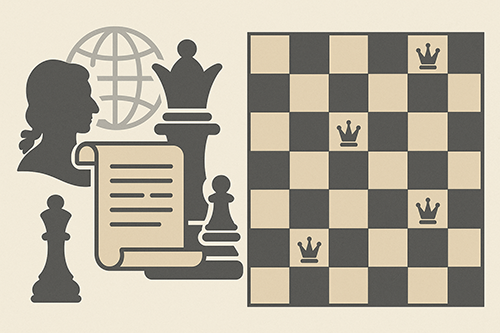History of the N-Queens Puzzle
Discover the fascinating history of the N-Queens puzzle, from its origins in 1848 to its importance in modern computer science.
History of the Puzzle

1848
The puzzle was originally published by German chess player Max Bezzel in 1848.
1850
Franz Nauck published the first solutions and extended the puzzle to the n-queens problem.
1972
Edsger Dijkstra used the puzzle as an example in his work on structured programming.
Today
The puzzle is widely used in computer science education to teach backtracking algorithms.
The Complete History of the N-Queens Puzzle
The N-Queens puzzle has a rich history spanning over 175 years, from its original conception in 1848 to its current importance in computer science. According to [Wikipedia](https://en.wikipedia.org/wiki/Eight_queens_puzzle), the problem was first proposed by German chess player Max Bezzel, marking the beginning of one of the most fascinating and studied mathematical problems in computing history.
The Origins: Max Bezzel and the Original Problem (1848)
Max Bezzel, a German chess player, first published the eight queens puzzle in 1848. The original problem was specifically about placing eight queens on a standard 8x8 chessboard. Bezzel not only proposed the problem but also recognized its combinatorial nature, establishing the foundation for the later development of solution algorithms.
Franz Nauck's Extension (1850)
Just two years later, in 1850, Franz Nauck published the first solutions to the problem and made a crucial contribution: he extended the puzzle to the general N-Queens problem. This generalization transformed the problem from a specific chess puzzle to a general mathematical problem that could be applied to boards of any size, opening new possibilities for research and application.
The Computing Era: Edsger Dijkstra (1972)
The N-Queens puzzle experienced a significant renaissance in 1972 when Edsger Dijkstra, one of the pioneers of computer science, used it as an example in his work on structured programming. Dijkstra not only popularized the problem but also demonstrated how it could be solved using backtracking algorithms, establishing the standard for algorithmic solution of the problem.
Impact on Computer Science Education
Since the 1970s, the N-Queens puzzle has become a cornerstone of computer science education. It's widely used to teach fundamental concepts like recursion, backtracking, structured programming, and algorithm analysis. The problem appears in virtually all algorithm textbooks and is a standard problem in university programming and data structures courses.
Modern Research and Applications
In recent decades, the N-Queens problem has been the subject of intensive research in areas like genetic algorithms, simulated annealing, constraint satisfaction, and combinatorial optimization. Researchers have developed specialized algorithms that can solve the problem for extremely large boards, with some algorithms capable of handling boards with more than 500,000 queens.
The Problem in Popular Culture
The N-Queens puzzle has transcended the academic realm and has appeared in popular culture. It has been used in video games, as mentioned in the official guide for "The 7th Guest", and has appeared in Japanese puzzles like "クイーンの問題" (Queens Problem). Its visually appealing nature and intellectual challenge have made it a favorite among puzzle enthusiasts.
Legacy and Current Relevance
Today, the N-Queens puzzle remains relevant for multiple reasons. It's a standard problem in programming interviews, appears in programming competitions, and is used to teach advanced algorithm concepts. Its conceptual simplicity combined with its computational complexity makes it a perfect example to illustrate the fundamental principles of computer science.